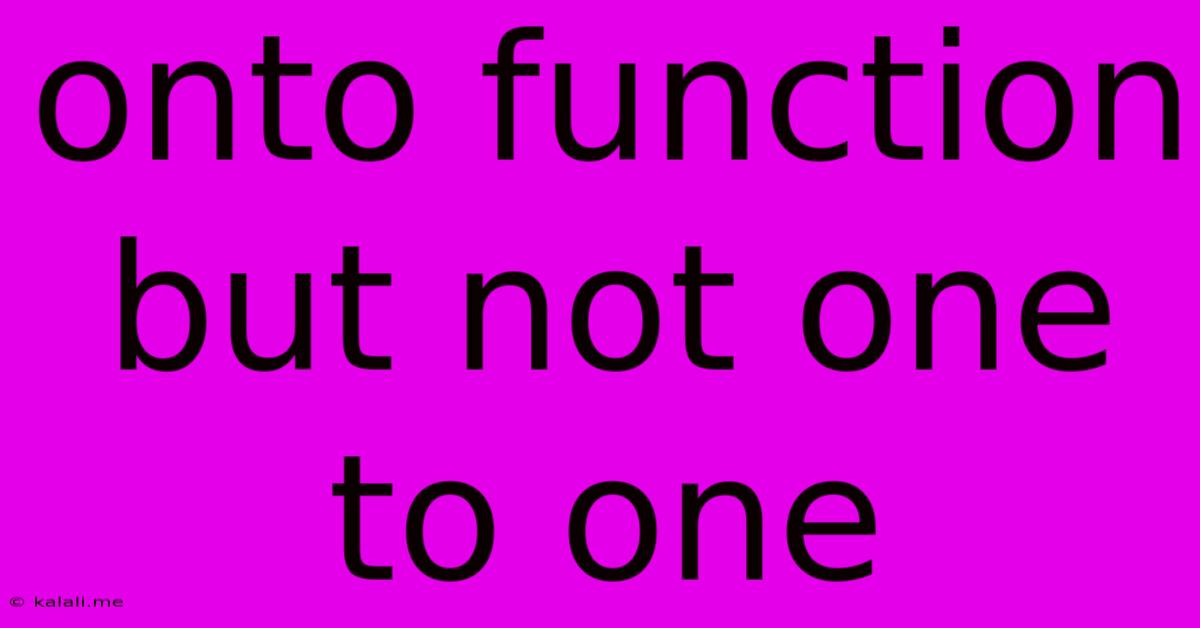Onto Function But Not One To One
Kalali
Jun 01, 2025 · 3 min read

Table of Contents
Onto Functions: When Every Output Has an Input (But Not Just One)
Understanding functions is crucial in mathematics, and a key aspect of this understanding lies in recognizing different types of functions. This article delves into onto functions, also known as surjective functions, focusing specifically on those that are not one-to-one. We'll explore the definition, provide illustrative examples, and contrast them with other function types. This will provide a solid foundation for anyone studying function properties.
What is an Onto Function?
An onto function, or surjection, is a function where every element in the codomain (the set of possible outputs) is mapped to by at least one element in the domain (the set of inputs). In simpler terms, every possible output has at least one corresponding input. This is in contrast to functions where some outputs might be "missed" – those are not onto.
The Key Difference: Onto vs. One-to-One
While an onto function guarantees that every element in the codomain is "hit," it doesn't restrict the number of inputs mapping to a single output. This is the crucial difference between onto and one-to-one (injective) functions. A one-to-one function requires that each output is mapped to by only one input. An onto function can have multiple inputs mapping to the same output.
Examples of Onto Functions that are NOT One-to-One:
Let's illustrate with examples:
- Example 1: Squaring Function (with restricted codomain)
Consider the function f(x) = x² where the domain is all real numbers and the codomain is the set of non-negative real numbers (ℝ₀⁺). This function is onto because every non-negative real number has at least one square root. However, it's not one-to-one because both positive and negative numbers square to the same positive value (e.g., f(2) = f(-2) = 4).
- Example 2: A Function from Integers to Even Integers:
Let's define a function g: ℤ → 2ℤ (integers to even integers) as g(x) = 2x. This function is onto because every even integer can be obtained by doubling an integer. However, it's not one-to-one because multiple integers map to the same even integer (e.g., g(1) = 2, g(-1) = -2, g(2) = 4, g(-2) = -4).
- Example 3: A Simple Set-Based Example:
Consider the sets A = {1, 2, 3} and B = {a, b}. Let's define the function h: A → B as h(1) = a, h(2) = b, h(3) = b. This function is onto because both 'a' and 'b' in the codomain B are mapped to. However, it's not one-to-one as two elements of A (2 and 3) map to the same element 'b' in B.
Visualizing Onto (But Not One-to-One) Functions:
Imagine a mapping diagram. For an onto function, every element in the codomain must have at least one arrow pointing to it. If it's not one-to-one, then at least one element in the codomain will have multiple arrows pointing to it.
Why is this distinction important?
Understanding the difference between onto and one-to-one functions is fundamental in various mathematical fields, including:
- Algebra: Studying function properties and their inverses.
- Calculus: Analyzing the behavior of functions and their derivatives.
- Discrete Mathematics: Working with sets and their relationships.
- Computer Science: Designing algorithms and data structures.
In conclusion, while an onto function ensures complete coverage of the codomain, the lack of a one-to-one property highlights the possibility of multiple inputs yielding the same output. Recognizing this distinction allows for a deeper understanding of function behavior and its implications across different mathematical applications.
Latest Posts
Latest Posts
-
Kirby And The Forgetton Land Coins
Jun 03, 2025
-
Why Was John The Baptist In Prison
Jun 03, 2025
-
Can I Download A Single Tab In Google Sheets
Jun 03, 2025
-
How To Get Rid Of Fingerprints
Jun 03, 2025
-
Calories In Cup Of Uncooked Rice
Jun 03, 2025
Related Post
Thank you for visiting our website which covers about Onto Function But Not One To One . We hope the information provided has been useful to you. Feel free to contact us if you have any questions or need further assistance. See you next time and don't miss to bookmark.